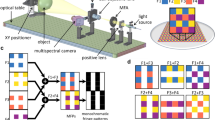Abstract
A single-image fringe projection profiling method suitable for dynamic applications was developed by combining an accurate camera calibration procedure and improved phase extraction procedures. The improved phase extraction process used a modified Hilbert transform with Laplacian pyramid algorithms to improve measurement accuracy. The camera calibration method used an accurate pinhole camera model and pixel-by-pixel calibration of the phase-height relationship. Numerical simulations and controlled baseline experiments were performed to quantify key error sources in the measurement process and verify the accuracy of the approach. Results from numerical simulations indicate that the resulting phase error can be reduced to less than 0.02 radians provided that parameters such as fringe spacing, random measured intensity noise, fringe contrast and frequency of spatial intensity noise are carefully controlled. Experimental results show that the effects of random temporal and spatial noise in typical CCD cameras for single fringe images limits the accuracy of the method to 0.04 radians in most applications. Quantitative results from application of the fringe projection method are in very good agreement with numerical predictions, demonstrating that it is possible to design both a fringe projection system and a measurement process to achieve a prespecified accuracy and resolution in the point-to-point measurement of the spatial (X, Y, Z) positions.
Similar content being viewed by others
References
McNeill, S.R., Sutton, M.A., Miao, Z., andMa, J., “Measurement of Surface Profile Using Digital Image Correlation,”Experimental Mechanics,37 (1),13–21 (1997).
Helm, J.D., Sutton, M.A. andMcNeill, S.R., “Improved Three-dimensional Image Correlation for Surface Displacement Measurement,”Opt. Eng.,35,1911–1920 (1996).
Tsai, R.Y., “An Efficient and Accurate Camera Calibration Technique for 3D Machine Vision,” Proceedings of the IEEE International Conference on Computer Vision and Pattern Recognition, 364–374 (1986).
Weng J., Cohen, P., Herniou, M., “Camera Calibration with Distortion Models and Accuracy Evaluation,”IEEE Trans. Pattern Anal. Mach. Intell.,14,965–980 (1992).
Takasaki, M., “Moiré Topography,”Appl. Opt.,9,1467–1472 (1970).
Masanoril, I., Toyohiko, Y., andTakashi, S., “Scanning Moiré Method and Automatic Measurement of 3-D Shapes,”Appl. Opt.,6,2152–2162 (1976).
Matssumoto, T., Kitagawa, Y., Adachi, M., andHayashi, A., “Moiré Topography for Three-dimensional Profile Measurement Using the Interference Fringes,”Opt. Eng.,31,2668–2672 (1992).
Suganuma, M. andYoshizawa, T., “Three-dimensional Shape Analysis by Use of a Projected Grating Image,”Opt. Eng.,30,1529–1533 (1991).
Larkin, K.G. andOreb, B.F., “Design and Assessment of Symmetrical Phase-shifting Algorithms,”J. Opt. Soc. Am.,9,1741–1748 (1992).
Hibino, K., Oreb, B.F., andFarrant, D.I., “Phase Shifting for Nonsinusoidal Waveforms with Phase-shifting Errors,”J. Opt. Soc. Am.,12,761–768 (1995).
Zhao, B. andSurrel, Y., “Effects of Quantization Error on the Computed Phase of Phase-shifting Measurements,”Appl. Opt.,36,2070–2075 (1997).
Hibino, K., Oreb, B.F., Farrant, D., andLarkin, K.G., “Phaseshifting Algorithms for Nonlinear and Spatially Nonuniform Phase Shifts,”J. Opt. Soc. Am.,14,918–930 (1997).
Hibino, K., Larkin, K.G., Oreb, B.F., andFarrant, D.I., “Phaseshifting Algorithms for Nonlinear and Spatially Nonuniform Phase Shifts: Reply to Comment,”J. Opt. Soc. Am.,15,1234–1235 (1998).
Huang, P.S., Jin, F., and Chiang, F.P., “Quantitative NDE of Corrosion by Digital Fringe Projection and Phase Shifting,” Proceedings of the SEM Spring Conference on Experimental and Applied Mechanics, Houston, TX, 305–306 (June 1998).
Huntley, J.M. and Coggrave, C.R., “High Speed Measurement of Discontinoous Surface Profiles,” International Union of Theoretical and Applied Mechanics Symposium on Advanced Optical Methods and Applications in Solid Mechanics, Poitiers-Futuroscope, France, 161–168 (Aug.–Sep. 1988).
Hornbeck, L.J., “Digital Light Processing for High-brightness, High-resolution Applications,”Proc. SPIE,3013,27–40 (1997).
Kato, J., Yamaguchi, I., Nakamura, T., andKuwashima, S., “Videorate Fringe Analyzer Based on Phase-shifting Electronic Moiré Patterns,”Appl. Opt.,36,8403–8412 (1997).
Takeda, M., Ika, H., andKobayasha, S., “Fourier Transform Method of Fringe Pattern Analysis for Computer Based Topography and Interferometry,”J. Opt. Soc. Am.,72,156–160 (1982).
Zweig, D.A., Hufnagel, R.E., “A Hilbert Transform Algorithm for Fringe-pattern Analysis,”Adv. Opt. Manufact. Test.,SPIE 1333,295–302 (1990).
Jaehne, B., Practical Handbook on Image Processing for Scientific Applications, Chemical Rubber Company Press, Cleveland, OH (1997).
Tang, S. andHung, Y.Y., “Fast Profilometer for the Automatic Measurement of 3-D Object Shapes,”Appl. Opt.,29,3012–3018 (1990).
Toyooka, S. andIwasa, Y., “Automatic Profilometry of 3-D Diffuse Objects by Spatial Phase Detection,”Appl. Opt.,25,1630–1633 (1986).
Gu, R., Yoshizawa, T., andOtani, Y., “One-step Phase Shift 3-D Surface Profilometry with Grating Projection,”Appl. Opt.,21 (1–2),61–75 (1994).
Burt, P.J. andAdelson, E.H., “The Laplacian Pyramid as a Compact Image Code,”IEEE Trans. Commun.,31,532–540 (1983).
Huntley, J.M., “Noise-immune Phase Unwrapping Algorithm,”Appl. Opt.,28,3268–3270 (1989).
Bone, D.J., “Fourier Fringe Analysis—The 2-dimensional Phase Unwrapping Problem,”Appl. Opt.,30,3627–3632 (1991).
Carter, W.H., “On Unwrapping 2-dimensional Phase Data in Contour Maps,”Opt. Commun.,94 (1–3),1–7 (1992).
Judge, T.R. andBryanstoncross, P.J., “A Review of Phase Unwrapping Techniques in Fringe Analysis,”Opt. Lasers Eng.,21,199–239 (1994).
Cusack, R., Huntley, J.M., andGoldrein, H.T., “Improved Noiseimmune Phase-unwrapping Algorithm,”Appl. Opt.,34,781–789 (1995).
Huntley, J.M. andSaldner, H.O., “Shape Measurement Temporal Phase Unwrapping: Comparison of Unwrapping Algorithms,”Maes. Sci. Tech.,8,986–992 (1997).
Fujigaki, M. and Morimoto, Y., “Automated Shape Analysis for Multiple Phase Fringes by Phase-shifting Method Using Fourier Transform,” Proceedings of the 11th International Conference on Experimental Mechanics,1,Oxford, UK, 711–715 (Aug. 1998).
Author information
Authors and Affiliations
Rights and permissions
About this article
Cite this article
Sutton, M.A., Zhao, W., McNeill, S.R. et al. Development and assessment of a single-image fringe projection method for dynamic applications. Experimental Mechanics 41, 205–217 (2001). https://doi.org/10.1007/BF02323136
Received:
Revised:
Issue Date:
DOI: https://doi.org/10.1007/BF02323136




